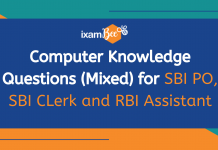The Reserve Bank of India (RBI) has guidelines for digital lending, aiming to make the process safer and more transparent for borrowers. If you’re someone who uses apps to take loans or is preparing for government banking exams, understanding these guidelines is crucial. Let’s break it down in simple terms so you can grasp what these changes mean for you.

What is Digital Lending?
Digital lending is when you apply for a loan through a mobile app or website. It’s quick, easy, and doesn’t require you to visit a bank. For example, if you need money urgently, you can download an app, fill in some details, and get the loan amount directly in your bank account. Sounds convenient, right? But with convenience comes risks, and that’s where RBI steps in.
Why Did RBI Introduce These Guidelines?
Over the past few years, digital lending has grown rapidly. However, there have been complaints about hidden charges, misuse of personal data, and aggressive recovery practices. To protect borrowers, RBI has set new rules to ensure fairness, transparency, and security in digital lending.
Key Points of RBI’s Digital Lending Guidelines
Let’s look at the main points of the guidelines and what they mean for you:
1. Direct Loan Disbursement and Repayment
RBI has made it clear that loans must be disbursed directly into your bank account. No middleman or third-party account should be involved. Similarly, repayments should also be made directly to the lender’s account. This ensures that your money doesn’t get stuck in someone else’s account.
Example: If you take a loan of ₹10,000, the amount will go straight to your bank account, not to any app or agent.
2. No Hidden Charges
Lenders must disclose all fees and charges upfront. This includes the Annual Percentage Rate (APR), which is the total cost of the loan, including interest and other charges. If any fee is not mentioned in the Key Fact Statement (KFS), the lender cannot charge you for it later.
Example: If the KFS says the APR is 15%, the lender cannot suddenly add extra charges without your knowledge.
3. Cooling-Off Period
RBI has introduced a cooling-off period, which is like a “think again” window. If you change your mind after taking a loan, you can cancel it within this period by paying only the principal and interest for the days you used the loan. No extra penalty!
Example: If you take a loan and realize you don’t need it, you can return the money within 3 days (for loans longer than 7 days) without any extra charges.
4. Data Privacy
Your personal data is precious, and RBI knows it. Lenders cannot access your phone’s contacts, photos, or other private information without your permission. They can only take one-time access for things like camera or location, and that too only for KYC (Know Your Customer) purposes.
Example: If a lending app asks for access to your contacts, you can say no, and they cannot force you.
5. Grievance Redressal
If you face any issues with a digital loan, you can complain to the lender’s grievance officer. If they don’t resolve your problem within 30 days, you can escalate it to the RBI’s Complaint Management System.
Example: If you’re charged extra fees unfairly, you can raise a complaint, and the lender has to address it within a month.
6. No Automatic Credit Limit Increase
Your credit limit cannot be increased automatically without your consent. Lenders must ask for your permission before increasing the limit.
Example: If your credit limit is ₹20,000, it cannot be increased to ₹30,000 unless you agree to it.
What Does This Mean for Borrowers?
These guidelines are a big win for borrowers. They ensure that digital lending is safe, transparent, and fair. You no longer have to worry about hidden charges, misuse of your data, or aggressive recovery tactics. It also means that you have more control over your loans and can make informed decisions.
What Does This Mean for Lenders?
For lenders, these guidelines mean stricter rules. They need to be more transparent about fees, protect customer data, and ensure that their apps follow RBI’s rules. Lenders also need to train their recovery agents to behave responsibly.
Conclusion
RBI’s digital lending guidelines are a step towards making the financial system more secure and borrower-friendly. Whether you’re a borrower or a banking aspirant, understanding these rules is essential. They not only protect you from unfair practices but also ensure that digital lending remains a reliable option for quick loans.
So, the next time you use a digital lending app, remember these guidelines. They’re there to protect you and make your borrowing experience smooth and hassle-free. Stay informed, stay safe!
ixamBee specializes in providing expert guidance and resources for banking exams 2024, ensuring that you are well-prepared for the Upcoming Bank Exams like RBI Grade B, NABARD Grade B, IBPS SO, and more. Our courses align with the bank exam calendar 2024, covering all the essential topics. With a focus on the upcoming bank jobs, our Previous Year Papers, BeePedia, SSC CGL, SSC CHSL, SSC MTS and other Mock Tests are designed to help you excel in upcoming banking exams.
Also Read:
Global Organizations and Their Functions: UN, IMF, WTO, and WHO
Major International Treaties and Their Impact on World Politics












